Revolutionizing Scoliosis Management: The Schroth Method in Physiotherapy
Introduction:
Scoliosis, a complex spinal condition, can be a challenging journey for many. But there's a beacon of hope in the physiotherapy world: the Schroth Method. This specialized approach has transformed scoliosis management, offering a targeted, effective way to improve posture, reduce pain, and enhance quality of life. Let's delve into what the Schroth Method involves and some specific tips for those embarking on this treatment path.
Understanding the Schroth Method:
Developed by Katharina Schroth, this method is not just a set of exercises; it's a philosophy of spinal rehabilitation specifically designed for scoliosis patients. It focuses on de-rotating, elongating, and stabilizing the spine through a series of exercises and breathing techniques, tailored to each person's unique spinal curvature.
Core Principles of the Schroth Method:
Three-Dimensional Treatment: Addresses the spine's curves from all angles, not just the obvious side-to-side curvature.
Breathing Techniques: Uses rotational angular breathing to reshape the rib cage and reduce spinal deformity.
Postural Awareness: Teaches patients to be aware of their posture throughout the day, not just during exercises.
Tips for Practicing the Schroth Method:
Find a Therapist: The first step is to work with a therapist to ensure proper guidance and technique.
Commit to Regular Practice: Consistency is key. Daily exercises, as prescribed by your therapist, are crucial for progress.
Focus on Breathing: Mastering the specific breathing techniques is a cornerstone of the Schroth Method. These breathing exercises are designed to help reshape the rib cage and improve spinal alignment.
Incorporate Postural Awareness: Apply the postural principles learned during your sessions to your daily activities. This constant mindfulness can significantly impact the effectiveness of the therapy.
Use Visual Feedback: Mirrors can be a helpful tool to self-monitor posture and alignment during exercises.
Stay Patient and Positive: Progress can be gradual. It's important to stay motivated and patient throughout the treatment journey.
Involve Your Support System: Having family or friends who understand your exercises and goals can provide invaluable support and encouragement.
Conclusion:
The Schroth Method in physiotherapy offers a proactive, non-surgical approach to managing scoliosis. With its focus on three-dimensional treatment, specialized breathing techniques, and postural awareness, it empowers individuals to take an active role in managing their condition. Remember, while this method is powerful, it requires dedication, consistency, and patience. Embracing the Schroth Method could be your first step towards a more aligned and comfortable life with scoliosis.
References:
Weiss HR, Moramarco M. "The Schroth Method of Physical Therapy for Scoliosis." Journal of Physical Therapy Science. This reference provides a detailed scientific overview of the Schroth Method, its principles, and effectiveness in scoliosis management.
Kuru T, Yeldan İ, Dereli EE, Özdinçler AR, Dikici F, Çolak İ. "The efficacy of three-dimensional Schroth exercises in adolescent idiopathic scoliosis: a randomised controlled clinical trial." Clinical Rehabilitation. This study presents clinical evidence on the effectiveness of the Schroth Method in adolescents with idiopathic scoliosis.
Schroth Method Official Website. This source offers comprehensive information about the Schroth Method, including its history, principles, and practical application tips.
Negrini S, Aulisa AG, Aulisa L, Circo AB, de Mauroy JC, Durmala J, Grivas TB, Knott P, Kotwicki T, Maruyama T, Minozzi S, O'Brien JP, Papadopoulos D, Rigo M, Rivard CH, Romano M, Wynne JH, Villagrasa M, Weiss HR, Zaina F. "2011 SOSORT guidelines: Orthopaedic and Rehabilitation treatment of idiopathic scoliosis during growth." Scoliosis. This guideline provides an overview of various treatments for idiopathic scoliosis, including physiotherapeutic approaches like the Schroth Method.
